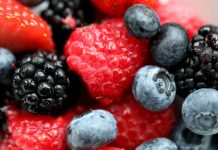The right nutrition can help you protect your heart and brain
Heart disease and stroke impact women differently than men, in ways researchers are just starting to understand. Of course, the nutrition basics are the same no matter your age or gender. Protecting your heart and brain should start when you’re young, and should include balanced eating and plenty of physical activity. But today we’re going to shine the spotlight on how women’s nutritional needs differ at certain points throughout the lifespan.
Basics for everyone
While taste buds are subjective and people may prefer a different list of staple foods, the basic plate model from Canada’s Food Guide is a good start for planning healthy meals, regardless of gender. It recommends that half your plate is made up of vegetables and fruit, a quarter is from whole grains, and the remaining quarter includes protein-rich foods, such as chicken, fish, tofu, beans or lentils. The food guide also emphasizes choosing fewer highly processed foods, fast foods and sweet beverages (such as pop or sports drinks).
In your 20s-40s:
It’s vital to build healthy habits in these years, because they can form your lifelong patterns. Aim to get eight hours of sleep each night, stay active, eat well and not smoke. A study found that young adults in this age range who drop their unhealthy habits and embrace a heart-healthy lifestyle can control and potentially even reverse the natural progression of coronary artery disease. It’s never too early to think about heart health.
Build healthy habits early, because they can form your life-long patterns.
Pregnancy: If you are contemplating motherhood, take 400 mg folic acid daily, which can help reduce the risk of birth defects. Once pregnant, choose a prenatal multivitamin, which should contain at least 18 mg iron.
It’s important to get enough heart-healthy omega-3 fats during pregnancy, which also serves to support the developing baby’s brain, eyes and nerves. Choose fatty fish (such as salmon or trout) a few times a week, but make sure to follow the guidelines for limiting high mercury fish, which can harm the growing baby. Here are more guidelines for nutrition during pregnancy and nutrition while breastfeeding.
In your 40s-60s:
When your period ends at menopause, the decrease in the hormone estrogen can increase your risk for heart disease, stroke and osteoporosis. So a balanced diet remains important during these years.
It’s vital to get adequate calcium and vitamin D, since both nutrients play a role in heart and bone health. Calcium requirements jump to 1200 mg at age 51 (previously 1000 mg), and vitamin D remains at 600 IU/day. It’s difficult to get enough vitamin D from food, so supplements are recommended.
Some studies also suggest that whole soy foods (such as tofu or edamame) and ground flax seeds may help manage menopause symptoms, since they contain plant-estrogens, which weakly mimic human estrogen. They are also a source of fibre and omega-3 fats, which protect heart health. Recent studies show that plant-estrogens may produce a positive impact on menopausal women, with no increased risk of heart disease (or breast cancer). Talk with your doctor before making any dietary changes, because the studies to-date are far from conclusive.
Older women
Aging is linked to loss of muscle mass, and may cause some nutrient deficiencies. Fight back with food! You can curb muscle wasting by ensuring that you include a source of protein at each meal. Remember Canada’s Food Guide plate? It includes a quarter-plate of protein-rich food – don’t skip it!
Older adults may lose some ability to absorb vitamin B12, calcium, iron and magnesium, which can result in deficiencies. Work with your doctor to determine if you have any nutrient deficiencies, which can be detected by a blood test.
Calorie needs tend to decrease with age, which begins when people become less active. It’s normal to notice a decrease in appetite, and it becomes even more important to make every bite count – choose foods to fit Canada’s Food Guide’s plate, rather than filling up on salty snacks or sweets, which don’t provide the nutrients your body needs.
Finally, bump up vitamin D. After age 70, vitamin D recommendations increase to 800 IU/day, so have a supplement handy.






























